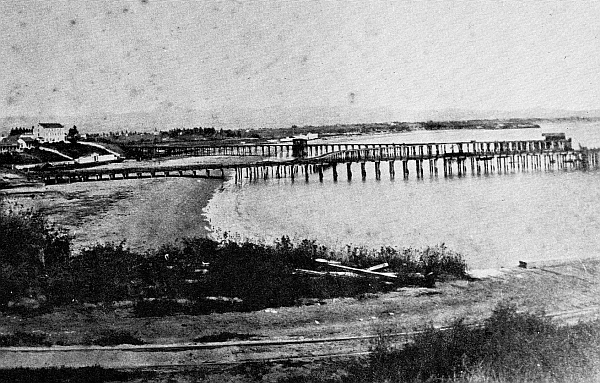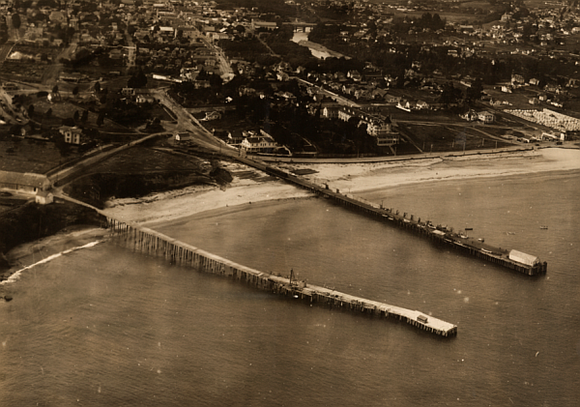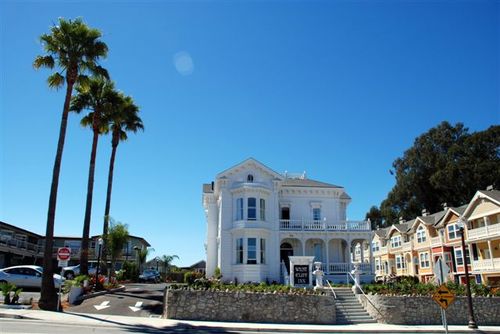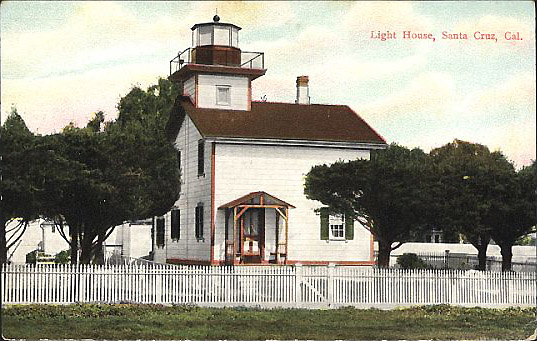Difference between revisions of "History Pages: 34 - When Santa Cruz Had Four Wharfs"
m (Carey moved page History Pages: 33 - When Santa Cruz Had Four Wharfs to History Pages: 34 - When Santa Cruz Had Four Wharfs) |
|||
| (8 intermediate revisions by the same user not shown) | |||
| Line 6: | Line 6: | ||
| − | One of the essential stops on a tour of Santa Cruz is the Municipal Wharf. Few realize, however, that the current wharf, completed in 1914, is only the latest in a series of | + | One of the essential stops on a tour of Santa Cruz is the [[Santa Cruz Municipal Wharf|Municipal Wharf]]. Few realize, however, that the current wharf, completed in 1914, is only the latest in a series of wharves (or wharfs, if you prefer) that have reached out from our section of coast into Monterey Bay over the past 150+ years. Railroads and, later, motor vehicles eventually ended most seaborne transport to and from Santa Cruz, but in the late 1870s the waterfront was a bustling hub of shipping and commerce, sporting as many as four wharves. |
| − | The History Pages have previously mentioned two of the earlier | + | The History Pages have previously mentioned two of the earlier wharves. The Anthony-Penfield wharf, first constructed in 1849, was later acquired, lengthened and rebuilt several times by the lime manufacturing company that built its warehouse on the cliff at the end of today’s Bay Street. First the company was Davis & Jordan, then Davis & Cowell, which after 1887 was owned solely by [[Cowell Lime Works|Henry Cowell]]. |
| Line 23: | Line 23: | ||
| − | |||
| − | |||
| + | A remarkable wide-angle aerial panoramic photograph, taken in 1906, shows a lot of the Santa Cruz coastal area. The detail at left shows the Cowell wharf at its greatest extent, just a year before it was destroyed by winter storms. The same section of the panoramic photo also shows the “railroad wharf”, terminus of the Santa Cruz & Felton railroad tracks and completed in 1875. The railroad wharf, third in the chronological sequence, was just west (toward Cowell wharf) of today’s Municipal Wharf, and was demolished in 1922. | ||
| + | Before the "railroad wharf", a second wharf was built by [[Gharky, S. David|David Gharky]] (spelled Gharkey on street signs, with several other spellings elsewhere) in 1855. It was later known as the “powder wharf”, because Gharky sold it to the [[California Powder Works]] (CPW) in 1865. Leon Rowland states that Gharky had lengthened the wharf in 1863. The Gharky/powder wharf stood on tall pilings that extended it well up the hill from beach level, to a point near today’s corner of Main and 1st Streets. The Gharky/powder wharf can be seen in the top photo, farthest away from the camera. | ||
| − | + | ||
| + | |||
| + | |||
| + | |||
| + | The building of the railroad wharf was part of the arrival of rail service in Santa Cruz. Soon after, the Powder Works completed its own rail siding connection to its plant up the San Lorenzo River, eliminating the need to haul powder by wagon down to the company's wharf. Rail service, in turn, proved to be better than coastal shipping, so there was no longer a need for the company-owned wharf and warehouse facilities on Beach Hill. Those were removed in 1883, which aided the shift in development of the area from shipping/commercial to upscale residential/tourist. Out-of-town visitors and wealthy residents would not have looked upon rumbling wagons full of blasting powder as a desirable neighborhood feature. | ||
The fourth and final wharf you would have seen in the late 1870s never touched the shore at all. It was the “cross wharf”, built in 1877 to connect the powder wharf to the railroad wharf at a point just beyond the surf line. It carried the tracks over to the powder wharf, allowing the CPW to dispense with powder storage on its wharf. | The fourth and final wharf you would have seen in the late 1870s never touched the shore at all. It was the “cross wharf”, built in 1877 to connect the powder wharf to the railroad wharf at a point just beyond the surf line. It carried the tracks over to the powder wharf, allowing the CPW to dispense with powder storage on its wharf. | ||
| + | [[File:LynchHouse_today.jpg|right|500px]] | ||
The photo at top shows the resulting construction, with the railroad wharf nearest the camera. The curve of the connecting wharf is hard to see from this angle. The photo appears to have been taken from the top of the Davis & Cowell wharf. Soon enough, the CPW stopped moving powder by ship (from Santa Cruz) altogether. The cross wharf only lasted for five years, until 1882, when both it and the “powder” wharf were torn down. | The photo at top shows the resulting construction, with the railroad wharf nearest the camera. The curve of the connecting wharf is hard to see from this angle. The photo appears to have been taken from the top of the Davis & Cowell wharf. Soon enough, the CPW stopped moving powder by ship (from Santa Cruz) altogether. The cross wharf only lasted for five years, until 1882, when both it and the “powder” wharf were torn down. | ||
| − | |||
Approaching the end of the 1870s, there were still only a few homes on Beach Hill and only one on West Cliff Drive. That one, built in 1877, belonged to [[Lynch, Sedgwick J.|Sedgwick Lynch]]. Lynch was probably the county’s busiest building contractor in the 1860s and 70s. He built the 1866 County Courthouse, several buildings along Pacific Avenue and probably both the Davis & Cowell and railroad wharfs. He did a lot of business with both Davis & Cowell and Frederick Hihn. | Approaching the end of the 1870s, there were still only a few homes on Beach Hill and only one on West Cliff Drive. That one, built in 1877, belonged to [[Lynch, Sedgwick J.|Sedgwick Lynch]]. Lynch was probably the county’s busiest building contractor in the 1860s and 70s. He built the 1866 County Courthouse, several buildings along Pacific Avenue and probably both the Davis & Cowell and railroad wharfs. He did a lot of business with both Davis & Cowell and Frederick Hihn. | ||
| Line 51: | Line 55: | ||
| − | |||
| − | After his death, the lighthouse-keeper position passed to his youngest daughter Laura, who tended the big oil lamp faithfully for the next 33 years. The lighthouse went dark in 1941, and subsequent erosion has left only a remnant of the old brick foundation visible at the cliff edge. The 1967 Abbot Memorial Lighthouse, home since 1986 to the [ | + | |
| + | Despite the constantly improving wharves and other shipping facilities, Santa Cruz was always a dangerous place to approach by sea, especially in winter. To help ships safely reach Santa Cruz, a lighthouse was built in 1869, helping pilots avoid those treacherous rocks just offshore as they came south from San Francisco, navigated around the point and headed for the wharves. The first lighthouse-keeper was [[Hecox family|Adna Hecox]], who came overland to Santa Cruz in the 1840s. He was one of the last ''alcaldes'' before California statehood, and remained one of the most active and respected Santa Cruz residents. Unfortunately, Hecox never became a ‘name on a sign’, so few remember him today. | ||
| + | |||
| + | After his death in 1883, the lighthouse-keeper position passed to his youngest daughter Laura, who tended the big oil lamp faithfully for the next 33 years. Laura Hecox was an avid amateur naturalist, and her collections formed the basis for today's [[Santa Cruz Natural History Museum]]. | ||
| + | |||
| + | The lighthouse went dark in 1941, and subsequent erosion has left only a remnant of the old brick foundation visible at the cliff edge. The 1967 Abbot Memorial Lighthouse, home since 1986 to the [[Santa Cruz Surfing Museum]], stands farther back but in approximately the same location, a reminder of earlier days. | ||
==Notes== | ==Notes== | ||
| Line 63: | Line 71: | ||
*1875-1922: railroad wharf | *1875-1922: railroad wharf | ||
*1877-1882: connecting (or "cross") wharf | *1877-1882: connecting (or "cross") wharf | ||
| − | *1904-1962: Pleasure Pier (built along with the first Casino and "plunge" | + | *1904-1962: Pleasure Pier (built along with the first Casino and "plunge") |
*1914-today: Municipal Wharf | *1914-today: Municipal Wharf | ||
| − | + | ===Further reading=== | |
| − | * Frank Perry | + | * Frank Perry et al. [https://www.santacruzmah.org/ohj "Notes on the History of Santa Cruz Wharves"], in the MAH Online History Journal |
| − | * For more on the 1906 aerial photograph, see the Peter Nurkse article "[https://history.santacruzpl.org/omeka/items/show/134531#?c=0&m=0&s=0&cv=0 Notes on the 1906 Aerial Panorama of Santa Cruz by George Lawrence]" on the SCPL website. | + | * For more on the 1906 aerial photograph, see the Peter Nurkse article "[https://history.santacruzpl.org/omeka/items/show/134531#?c=0&m=0&s=0&cv=0 Notes on the 1906 Aerial Panorama of Santa Cruz by George Lawrence]" on the SCPL website. |
| + | * Related: [[:Category:Bridges, wharves and piers]] | ||
| + | |||
| + | For more on the lighthouse area: | ||
| + | * Frank Perry, [[Lighthouse Point: Illuminating Santa Cruz (2002 book)]]. Santa Cruz, Calif: Otter B Books | ||
Next: [[History Pages: 34 - The first book on Santa Cruz history, from 1879]] | Next: [[History Pages: 34 - The first book on Santa Cruz history, from 1879]] | ||
[[Category:History pages]] | [[Category:History pages]] | ||
Latest revision as of 18:09, 20 October 2023
For a table of contents, see History pages.
One of the essential stops on a tour of Santa Cruz is the Municipal Wharf. Few realize, however, that the current wharf, completed in 1914, is only the latest in a series of wharves (or wharfs, if you prefer) that have reached out from our section of coast into Monterey Bay over the past 150+ years. Railroads and, later, motor vehicles eventually ended most seaborne transport to and from Santa Cruz, but in the late 1870s the waterfront was a bustling hub of shipping and commerce, sporting as many as four wharves.
The History Pages have previously mentioned two of the earlier wharves. The Anthony-Penfield wharf, first constructed in 1849, was later acquired, lengthened and rebuilt several times by the lime manufacturing company that built its warehouse on the cliff at the end of today’s Bay Street. First the company was Davis & Jordan, then Davis & Cowell, which after 1887 was owned solely by Henry Cowell.
A remarkable wide-angle aerial panoramic photograph, taken in 1906, shows a lot of the Santa Cruz coastal area. The detail at left shows the Cowell wharf at its greatest extent, just a year before it was destroyed by winter storms. The same section of the panoramic photo also shows the “railroad wharf”, terminus of the Santa Cruz & Felton railroad tracks and completed in 1875. The railroad wharf, third in the chronological sequence, was just west (toward Cowell wharf) of today’s Municipal Wharf, and was demolished in 1922.
Before the "railroad wharf", a second wharf was built by David Gharky (spelled Gharkey on street signs, with several other spellings elsewhere) in 1855. It was later known as the “powder wharf”, because Gharky sold it to the California Powder Works (CPW) in 1865. Leon Rowland states that Gharky had lengthened the wharf in 1863. The Gharky/powder wharf stood on tall pilings that extended it well up the hill from beach level, to a point near today’s corner of Main and 1st Streets. The Gharky/powder wharf can be seen in the top photo, farthest away from the camera.
The building of the railroad wharf was part of the arrival of rail service in Santa Cruz. Soon after, the Powder Works completed its own rail siding connection to its plant up the San Lorenzo River, eliminating the need to haul powder by wagon down to the company's wharf. Rail service, in turn, proved to be better than coastal shipping, so there was no longer a need for the company-owned wharf and warehouse facilities on Beach Hill. Those were removed in 1883, which aided the shift in development of the area from shipping/commercial to upscale residential/tourist. Out-of-town visitors and wealthy residents would not have looked upon rumbling wagons full of blasting powder as a desirable neighborhood feature.
The fourth and final wharf you would have seen in the late 1870s never touched the shore at all. It was the “cross wharf”, built in 1877 to connect the powder wharf to the railroad wharf at a point just beyond the surf line. It carried the tracks over to the powder wharf, allowing the CPW to dispense with powder storage on its wharf.
The photo at top shows the resulting construction, with the railroad wharf nearest the camera. The curve of the connecting wharf is hard to see from this angle. The photo appears to have been taken from the top of the Davis & Cowell wharf. Soon enough, the CPW stopped moving powder by ship (from Santa Cruz) altogether. The cross wharf only lasted for five years, until 1882, when both it and the “powder” wharf were torn down.
Approaching the end of the 1870s, there were still only a few homes on Beach Hill and only one on West Cliff Drive. That one, built in 1877, belonged to Sedgwick Lynch. Lynch was probably the county’s busiest building contractor in the 1860s and 70s. He built the 1866 County Courthouse, several buildings along Pacific Avenue and probably both the Davis & Cowell and railroad wharfs. He did a lot of business with both Davis & Cowell and Frederick Hihn.
As a building contractor, Lynch must have enjoyed watching the hustle and bustle of commerce, for he built his home where it commanded a view of the entire waterfront area. It still does today, as you can see from the attached modern photo. His choice of location did not, however, immediately set off a West Cliff Drive building boom. You can see the house in the 1906 aerial photo, standing in splendid isolation between the Cowell warehouse/wharf and the railroad wharf. The house remains today (seen in the photo at right), repurposed as a B&B.
Despite the constantly improving wharves and other shipping facilities, Santa Cruz was always a dangerous place to approach by sea, especially in winter. To help ships safely reach Santa Cruz, a lighthouse was built in 1869, helping pilots avoid those treacherous rocks just offshore as they came south from San Francisco, navigated around the point and headed for the wharves. The first lighthouse-keeper was Adna Hecox, who came overland to Santa Cruz in the 1840s. He was one of the last alcaldes before California statehood, and remained one of the most active and respected Santa Cruz residents. Unfortunately, Hecox never became a ‘name on a sign’, so few remember him today.
After his death in 1883, the lighthouse-keeper position passed to his youngest daughter Laura, who tended the big oil lamp faithfully for the next 33 years. Laura Hecox was an avid amateur naturalist, and her collections formed the basis for today's Santa Cruz Natural History Museum.
The lighthouse went dark in 1941, and subsequent erosion has left only a remnant of the old brick foundation visible at the cliff edge. The 1967 Abbot Memorial Lighthouse, home since 1986 to the Santa Cruz Surfing Museum, stands farther back but in approximately the same location, a reminder of earlier days.
Notes
Santa Cruz wharf chronology:
- 1849-1856: Anthony-Penfield wharf
- 1855-1865: Gharky wharf
- 1856-1907: Davis and Jordan / Davis and Cowell / Cowell wharf (replaced Anthony-Penfield)
- 1865-1882: California Powder Works wharf (from Gharky)
- 1875-1922: railroad wharf
- 1877-1882: connecting (or "cross") wharf
- 1904-1962: Pleasure Pier (built along with the first Casino and "plunge")
- 1914-today: Municipal Wharf
Further reading
- Frank Perry et al. "Notes on the History of Santa Cruz Wharves", in the MAH Online History Journal
- For more on the 1906 aerial photograph, see the Peter Nurkse article "Notes on the 1906 Aerial Panorama of Santa Cruz by George Lawrence" on the SCPL website.
- Related: Category:Bridges, wharves and piers
For more on the lighthouse area:
- Frank Perry, Lighthouse Point: Illuminating Santa Cruz (2002 book). Santa Cruz, Calif: Otter B Books
Next: History Pages: 34 - The first book on Santa Cruz history, from 1879



